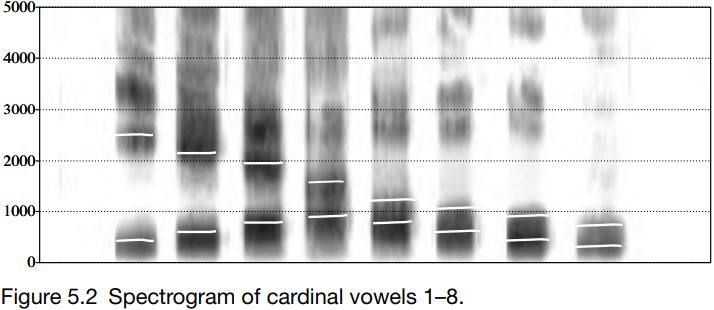


 Grammar
Grammar
 Tenses
Tenses
 Present
Present
 Past
Past
 Future
Future
 Parts Of Speech
Parts Of Speech
 Nouns
Nouns
 Verbs
Verbs
 Adverbs
Adverbs
 Adjectives
Adjectives
 Pronouns
Pronouns
 Pre Position
Pre Position
 Preposition by function
Preposition by function 
 Preposition by construction
Preposition by construction
 Conjunctions
Conjunctions
 Interjections
Interjections
 Grammar Rules
Grammar Rules
 Linguistics
Linguistics
 Semantics
Semantics
 Pragmatics
Pragmatics
 Reading Comprehension
Reading Comprehension|
Read More
Date: 2023-09-18
Date: 14-6-2022
Date: 2023-10-27
|
There is a relatively simple correspondence between tongue height, front ness and backness, and the relative positions of F1 and F2.
Figure 5.2 shows spectrograms of the eight primary cardinal vowels. The formants are shown with white lines.
The first formant relates to vowel height. Close vowels have a low F1, and open vowels have a high F1. This means that CV1 [i] and CV8 [u] both have a low F1 of approximately the same value, while CV4 [a] and CV5 [ɑ] have an F1 which is comparatively high, because these vowels are both open. The scale used on spectrograms is normally linear, which means that e.g. an interval of 100 Hz is represented as an equal interval at all points in the graph. Our hearing, however, is not like this: the human ear is more sensitive to changes in frequency in the lower ranges than in upper ranges; so the difference between e.g. 400 Hz and 600 Hz sounds much bigger than the difference between e.g. 2100 Hz and 2300 Hz. So although the differences between the F1 values for CV1 and CV4 do not look great, they are quite significant from the point of view of hearing.
The second formant relates to frontness and backness. Front vowels have a high F2, but back vowels have a low F2. Rounding the lips also lowers F2, so as we move through cardinals 1–8, F2 gets progressively lower.

|
|
|
|
4 أسباب تجعلك تضيف الزنجبيل إلى طعامك.. تعرف عليها
|
|
|
|
|
|
|
أكبر محطة للطاقة الكهرومائية في بريطانيا تستعد للانطلاق
|
|
|
|
|
|
|
أصواتٌ قرآنية واعدة .. أكثر من 80 برعماً يشارك في المحفل القرآني الرمضاني بالصحن الحيدري الشريف
|
|
|